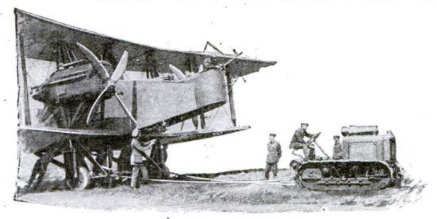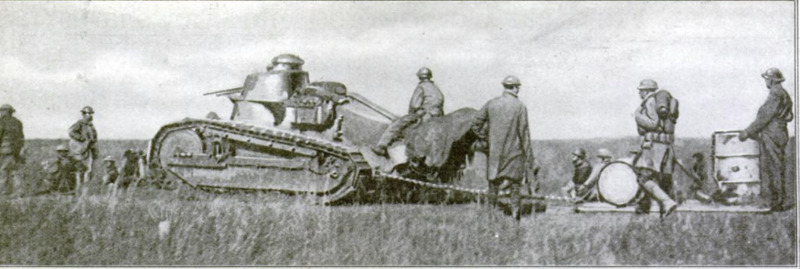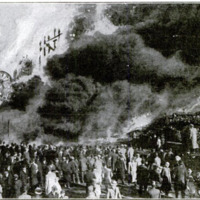-
Titolo
-
Converting weapons and war vehicles for peace use
-
Article Title and/or Image Caption
-
Title: Can We Beat Our Swords into Plowshares?
-
Subtitle: It is difficult to salvage the giant war machine, once it goes to the scrap-heap
-
extracted text
-
THERE is none too much war
material inthe world to-day for the
use of the world if 2 peace-keep-
ing league is formed. The war ma-
terial should be divided among the na-
tious’ according to their needs, and
then each nation should be permitted,
under «the league, to produce only a
. certain limited quantity thereafter.
A breach of this understanding would
put that particular nation under a
ban.
But, assuming that the material is
* not to be so disposed of, and that there
is to be no adjustment between the
Peace League nations to distribute the
war material among them for future
war needs or world police needs, then
the question arises, to what peace use
can the material best be converted?
From War to Peace
The tanks, especially the smaller
or whippet tanks, largely used by the
French, could doubtless be converted
into tractors. The tank itself is mere-
Iy a tractor converted from peace to
war use, and it would be a very simple
matter to convert the tank back
again from war to peace use. Few
of the farms of France are large
enough for the individual farmers
to own tractors for their farm-
work, but proper arrangements
could doubtless be made, either
by the government or by private
companies, to supply tractors for
all-round farm use, on terms that
would be acceptable to the small
French farmers.
In the Ukraine, however, and
other parts of Russia, there would
be a wider use for such reconverted
tanks, but they would not have
very ‘much value even for that
purpose. It would be much sim-
pler, with our means of quantity
production in this country, to pro-
duce tractors specially designed
for the work. At best reconverted
tractors could never compete with
tractors made especially for farm
se.
The main value of war material
at the present time lies in guns,
ammunition, and ships. These
guns and the projectiles made for
them would have no value except
as old metal. The |
sume is true of
shoulder rifles, A
shoulder gun |
that cost, say, |
$50 to make |
might bring fifty cents or a dollar.
Big cannon costing $50,000 to build
might be worth from $100 to $200."
As to Airplanes
The cost of transportation and
breaking up of the big guns must he
taken into account. The same holds
true of the big shells. They would
bring as old metal only a very small
fraction of their original cost. There-
fore, if one per cent of the guns and
‘ammunition could be sold for what it is
worth for war uses to the smaller na-
tions, it would be u better bargain
than it would be to attempt to recon-
vert. or utilize for other purposes all
the material there is.
The airplane engine, of which the
Liberty motor is a very good example,
is a very highly specialized product,
made for the purpose of generating
the maximum power for a given period.
Every part of it is just as strong us
every other part, and it has been so
tested and timed and tuned that when
it goes to pieces it practically goes to
pieces after the manner of the one-
horse shay. Such a motor is not in-
tended for continuous use. It is in-
tended only for u brief and steenuous
use, and the life of the Liberty motor
under full load or running at a speed
where it is doing its best, I believe, is
only about elghty hours.
Some of the airplanes, especially
the bomb-carrying airplanes, may have
a use as mailcarriers or for similar
purposes; but such use is at the present
time largely problematical.
There is one war measure that
will have the very largest kind of
peace use. 1 refer to the establish-
ment of plants for the fixation of
atmospheric nitrogen. Had the war
continued a little longer, we should
have had some very large and well
equipped plants which could in time
of peace be utilized for making ferti-
lizer; but most of the work on these
plants has now been arrested.
Fixation of Atmospheric Nitrogen
“There i no one thing more needed
in this country, as an industrial de
velopment, than plants for the fixa-
tion of atmospheric nitrogen, particu
larly for the manufacture of fertilizers
for agricultural use. The government
ban should be taken off waterpower
throughout the country, so that individ-
ual enterprise may utilize that power
for the synthetic manufacture of fer-
tilizers.
Allof the water passing over Niagara
Falls should be utilized to produce
electricity for industrial uses, and a
large amount of this could very well
be applied to the manufacture of
fertilizers, There is practically an
unlimited demand for cheap fertilizers
for the farms.
Many of these power plants could be
shut off in order that the water might
be returned to the falls peri-
odically for scenic purposes
but even then it would be a
very costly display.
Niagara's Wasted Power
It is estimated that 16,000,
000 horsepower is running to
waste at Niagara Falls. To
produce this power with mod-
ern steam boilers would re
quire 32,000,000 pounds or
16,000 tons of bituminous
coal an hour. If such coal
were tc. be appraised at $3
a ton laid down at the plant,
the 16,000 tons would be
worth $1,152,000. That
would be the daily cost of
the coal supply to produce
that amount of power. The
value of the water that is
wasted is therefore about
$300,000,000 a year. This in
gold would weigh 450 tons.
A conflagration the size
of the great
London fire
could be pro-
vided once
every sixty
days for pub-
lic entertain-
ment and
amusement
for a sum
equal to that
which is run-
ning to waste
at Niagara
Falls.
The burning of Rome by Nero was
a very inexpensive piece of amusement
compared with that which is pro-
vided for bridal couples who visit
Niagara Falls.
Enormous quantities of tri-nitro-
toluene—that is to say, T.N.T.—and
nitrate of ammonia have been made
into high explosives. The best way to
employ these materials for peace use
would be in the manufacture of high
explosives. Stupendous quantities of
high explosives are made in the United
States annually for industrial use. To
a considerable extent, however, T.N.T.
would have perhaps the higher value
for industrial purposes. Nitrate of
ammonia is one of the best fertilizers
in the world, and would be worth for
farm use all that it cost to produce it.
The most important use to which war
‘material could beadapted for a period of
peace is the machinery that has been
constructed during the war for the manu-
factureof war materials. There
are vast quantities of such ma-
terials, and large buildings
have been erected for the
manufacture of war imple-
ments. Nearly all of this
machinery is very readily
adaptable to the manufac-
ture of implements of peace.
Valuable War Machinery
For example, the buildings
that have been erected and
the machinery that has been
installed in them for the
manufacture of war tanks
can very well and profitably
be employed for making farm
tractors and automobiles and
heavy trucks for industrial
use.
The vast equipment for
the production of airplane en-
gines can very readily be
utilized in major part of
automobile and farm trace
Tor ‘eng fates.
One of the
largest manu-
facturers of
munitions of
war in the
vicinity of
New York is
already plan-
ningtolaunch
out in a large
way inthe
production of
harvester ma-
chinery.
-
Autore secondario
-
Hudson Maxim (Article writer)
-
Lingua
-
eng
-
Data di rilascio
-
1919-02
-
pagine
-
65-66
-
Diritti
-
Public domain (Google digitized)
-
Archived by
-
Davide Donà
-
Marco Bortolami (editor)







